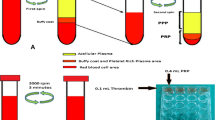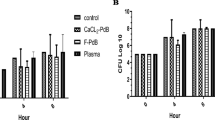Abstract
Purpose
Infected wounds, such as diabetic foot infections, are mostly polymicrobial and microorganisms have high resistance rates to antimicrobials. Infected wounds in diabetic patients have high cost, morbidity, and mortality rates. Based on these facts, there is a need for supportive localized treatment options such as platelet-rich plasma (PRP) implementations. Demonstrating the in vitro antimicrobial effect, our aim was to lead up to clinical trials of localized PRP implementations in infected wounds such as diabetic foot infections. In this study, we aimed to demonstrate the in vitro antibacterial activity of PRP against methicilin-resistant Staphylococcus aureus (MRSA) and three more multi-drug resistant bacteria species that are important and hard-to-treat in wound infections.
Materials and methods
In vitro antimicrobial activity of autologous PRP, platelet-poor plasma (PPP), and phosphate-buffered saline (PBS) on methicillin-resistant Staphylococcus aureus, vancomycin-resistant Enterococcus spp., extended spectrum beta lactamase producing Klebsiella pneumoniae, and carbapenem-resistant Pseudomonas aeruginosa was compared by assessment of bacterial growth on agar plates and antimicrobial susceptibility test results.
Results
When compared to control group, PRP and PPP significantly suppressed bacterial growth of MRSA, K. pneumoniae, and P. aeruginosa at 1st, 2nd, 5th, and 10th hours of incubation (p < 0.05). VRE was the only bacteria that PRP and PPP showed limited activity against. When compared to PPP, PRP showed higher activity against MRSA, K. pneumoniae, and P. aeruginosa. However, the differences between PRP and PPP were statistically significant only against MRSA and P. aeruginosa at the first hour of incubation.
Conclusions
Emerging PRP and other platelet-derived products seem to be promising alternative tools besides antibiotic treatment, debridement, negative pressure wound therapy, hyperbaric oxygen therapy, and other treatment options for treating diabetic foot infections.





Similar content being viewed by others
References
Friedman ND, Temkin E, Carmeli Y. The negative impact of antibiotic resistance. Clin Microbiol Infect. 2016;22(5):416–22.
Huysman E, Mathieu C. Diabetes and peripheral vascular disease. Acta Chir Belg. 2009;109(5):587–94.
Lipsky BA. International consensus group on diagnosing, treating the infected diabetic foot. A report from the international consensus on diagnosing and treating the infected diabetic foot. Diabetes Metab Res Rev. 2004;20(Suppl 1):S68-77.
Yeaman MR. Platelets in defense against bacterial pathogens. Cell Mol Life Sci. 2010;67(4):525–44.
Piccin A, Di Pierro AM, Canzian L, Primerano M, Corvetta D, Negri G, et al. Platelet gel: a new therapeutic tool with great potential. Blood Transfus. 2017;15(4):333–40.
Cetinkaya RA, Yilmaz S, Unlu A, Petrone P, Marini C, Karabulut E, et al. The efficacy of platelet-rich plasma gel in MRSA-related surgical wound infection treatment: an experimental study in an animal model. Eur J Trauma Emerg Surg. 2017.
Yang LC, Hu SW, Yan M, Yang JJ, Tsou SH, Lin YY. Antimicrobial activity of platelet-rich plasma and other plasma preparations against periodontal pathogens. J Periodontol. 2015;86(2):310–8.
Grigoropoulou P, Eleftheriadou I, Jude EB, Tentolouris N. Diabetic foot infections: an update in diagnosis and management. Curr Diab Rep. 2017;17(1):3.
Kosinski MA, Lipsky BA. Current medical management of diabetic foot infections. Expert Rev Anti Infect Ther. 2010;8(11):1293–305.
Yeaman MR. Platelets: at the nexus of antimicrobial defence. Nat Rev Microbiol. 2014;12(6):426–37.
Steed DL. Clinical evaluation of recombinant human platelet-derived growth factor for the treatment of lower extremity diabetic ulcers. Diabetic Ulcer Study Group. J Vasc Surg. 1995;21(1):71–8; discussion 9–81.
Wieman TJ, Smiell JM, Su Y. Efficacy and safety of a topical gel formulation of recombinant human platelet-derived growth factor-BB (becaplermin) in patients with chronic neuropathic diabetic ulcers. A phase III randomized placebo-controlled double-blind study. Diabetes Care. 1998;21(5):822–7.
Hemecour P. Sodium carboxymethylcellulose aqueous-based gel vs. becaplermin gel in patients with nonhealing lower extremity diabetic ulcers. Wounds. 1998;10:69–75.
Smiell JM, Wieman TJ, Steed DL, Perry BH, Sampson AR, Schwab BH. Efficacy and safety of becaplermin (recombinant human platelet-derived growth factor-BB) in patients with nonhealing, lower extremity diabetic ulcers: a combined analysis of four randomized studies. Wound Repair Regen. 1999;7(5):335–46.
Robson M. Integrating the results of phase IV (postmarketing) clinical trial with four previous trials reinforces the position that Regranex (becaplermin) gel 0.01% is an effective adjunct to the treatment of diabetic foot ulcers. J Appl Res. 2005(5):35–45.
Amable PR, Carias RB, Teixeira MV, da Cruz Pacheco I, Correa do Amaral RJ, Granjeiro JM, et al. Platelet-rich plasma preparation for regenerative medicine: optimization and quantification of cytokines and growth factors. Stem Cell Res Ther. 2013;4(3):67.
Jago R, Jacox RF. Cellular source and charcter of a heatstable bactericidal property associated with rabbit and rat platelets. J Exp Med. 1961;113:701–11.
Weksler BB, Nachman RL. Rabbit platelet bactericidal protein. J Exp Med. 1971;134(5):1114–30.
Kahn RA, Flinton LJ. The relationship between platelets and bacteria. Blood. 1974;44(5):715–21.
Czuprynski CJ, Balish E. Interaction of rat platelets with Listeria monocytogenes. Infect Immun. 1981;33(1):103–8.
Miragliotta G, Lafata M, Jirillo E. Anti-bacterial activity mediated by human platelets. Agents Actions. 1988;25(3–4):401–6.
Li H, Li B. PRP as a new approach to prevent infection: preparation and in vitro antimicrobial properties of PRP. J Vis Exp. 2013(74):e50351.
Li H, Hamza T, Tidwell JE, Clovis N, Li B. Unique antimicrobial effects of platelet-rich plasma and its efficacy as a prophylaxis to prevent implant-associated spinal infection. Adv Healthc Mater. 2013;2(9):1277–84.
Mariani E, Filardo G, Canella V, Berlingeri A, Bielli A, Cattini L, et al. Platelet-rich plasma affects bacterial growth in vitro. Cytotherapy. 2014;16(9):1294–304.
Fitzpatrick J, Bulsara MK, McCrory PR, Richardson MD, Zheng MH. Analysis of platelet-rich plasma extraction: variations in platelet and blood components between 4 common commercial kits. Orthop J Sports Med. 2017;5(1):2325967116675272.
Dhurat R, Sukesh M. Principles and methods of preparation of platelet-rich plasma: a review and author’s perspective. J Cutan Aesthet Surg. 2014;7(4):189–97.
Drago L, Bortolin M, Vassena C, Taschieri S, Del Fabbro M. Antimicrobial activity of pure platelet-rich plasma against microorganisms isolated from oral cavity. BMC Microbiol. 2013;13:47.
Anitua E, Alonso R, Girbau C, Aguirre JJ, Muruzabal F, Orive G. Antibacterial effect of plasma rich in growth factors (PRGF(R)-Endoret(R)) against Staphylococcus aureus and Staphylococcus epidermidis strains. Clin Exp Dermatol. 2012;37(6):652–7.
Moojen DJ, Everts PA, Schure RM, Overdevest EP, van Zundert A, Knape JT, et al. Antimicrobial activity of platelet-leukocyte gel against Staphylococcus aureus. J Orthop Res. 2008;26(3):404–10.
Chen L, Wang C, Liu H, Liu G, Ran X. Antibacterial effect of autologous platelet-rich gel derived from subjects with diabetic dermal ulcers in vitro. J Diabetes Res. 2013;2013:269527.
Bielecki TM, Gazdzik TS, Arendt J, Szczepanski T, Krol W, Wielkoszynski T. Antibacterial effect of autologous platelet gel enriched with growth factors and other active substances: an in vitro study. J Bone Jt Surg Br. 2007;89(3):417–20.
Yang HS, Shin J, Bhang SH, Shin JY, Park J, Im GI, et al. Enhanced skin wound healing by a sustained release of growth factors contained in platelet-rich plasma. Exp Mol Med. 2011;43(11):622–9.
Sun S, Wang C, Chen D, Cen S, Lv X, Wen X, et al. Combating superbug without antibiotic on a postamputation wound in a patient with diabetic foot. Int J Low Extrem Wounds. 2016;15(1):74–7.
Author information
Authors and Affiliations
Corresponding author
Ethics declarations
Conflict of interest
Riza Aytac Cetinkaya, Ercan Yenilmez, Patrizio Petrone, Soner Yılmaz, Bayhan Bektore, Berksan Simsek, Tugba Kula Atik, Mustafa Ozyurt, and Aytekin Ünlü declare that they have not conflict of interest.
Informed consent
The study was approved by the Institutional Ethics Committee of Haydarpasa Numune Training and Research Hospital on March 13, 2017.
Rights and permissions
About this article
Cite this article
Çetinkaya, R.A., Yenilmez, E., Petrone, P. et al. Platelet-rich plasma as an additional therapeutic option for infected wounds with multi-drug resistant bacteria: in vitro antibacterial activity study. Eur J Trauma Emerg Surg 45, 555–565 (2019). https://doi.org/10.1007/s00068-018-0957-0
Received:
Accepted:
Published:
Issue Date:
DOI: https://doi.org/10.1007/s00068-018-0957-0




